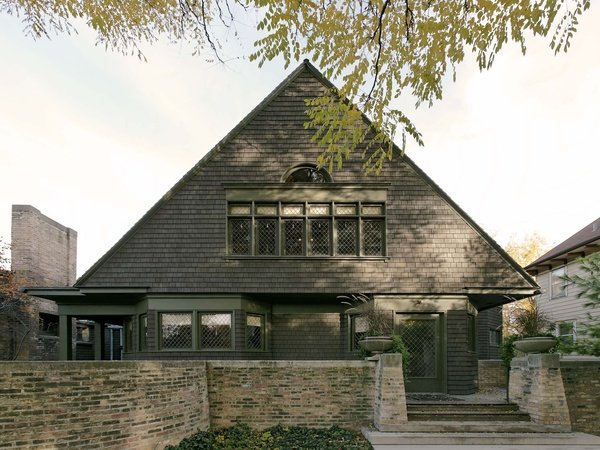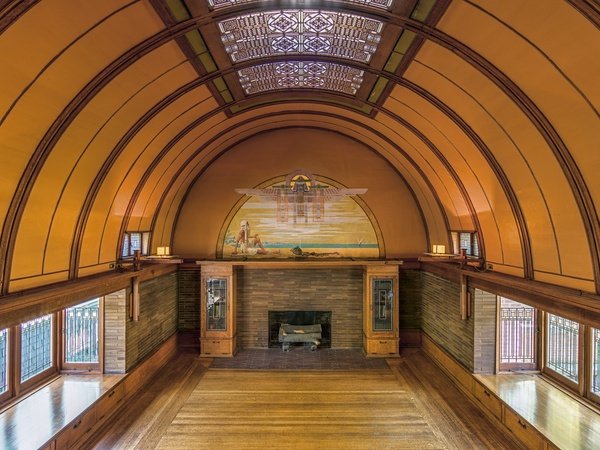Frank Lloyd Wright Trust: Wright Home and Studio
The Frank Lloyd Wright Trust operates public tours, programs, and events at major Wright sites, three of which are historic houses: Wright’s Home and Studio (1889/1898) in Oak Park, the Frederick C. Robie House (1908-10) in Chicago’s Hyde Park, and the Emil Bach House (1915) in Chicago’s Rogers Park. The Trust’s other sites are public buildings, Unity Temple (1905-08) in Oak Park and The Rookery (1905-07) in downtown Chicago.
951 Chicago Avenue
Oak Park, IL 60302
312-994-4000
Regular tours daily, 10am-4pm.
-
Arts and Crafts
The English Arts and Crafts movement, which promoted craftsmanship, simplicity, and integrity in art, architecture, and design, provided a powerful impetus to Frank Lloyd Wright’s principles, and informed the design of the architect’s Oak Park home.

-
Prairie Style
Developed at his Oak Park studio during the first decade of the 20th century, Wright’s Prairie style represented a bold new approach to domestic architecture. Inspired by the expansive landscape of America’s Midwest, the Prairie style was the first uniquely American architectural style of what has been called “the American Century.”

-
Shingle Style
For the exterior of his Oak Park home, Wright adapted the picturesque Shingle style, fashionable for the vacation homes of prosperous East Coast families and favored by his first employer, the architect Joseph Lyman Silsbee.

-
Archives
Comprising examples of Wright’s earliest furnishings and decorative arts, along with personal effects, correspondence, and photographs, the Trust’s collections detail Wright’s formative years in Chicago.

-
Playroom
The 1895 playroom on the second floor of the home is one of the great spaces of Wright’s early career. Designed to inspire and nurture his six children, the room is a physical expression of Wright’s belief that, “For the same reason that we teach our children to speak the truth, or better still live the truth, their environment ought to be as truly beautiful as we are capable of making it.”

-
Organic Design
Bold, innovative, and architectural, Wright’s furniture is an integral element of his Prairie interiors. In accordance with his philosophy of “organic” architecture, Wright’s furniture is conceived in harmony with each specific commission. Today Wright’s Home and Studio displays examples of Wright’s earliest furniture designs and provides a unique perspective on the development of the architect’s organic interiors.

-
Inglenook
The ground floor of Wright’s Oak Park home is centered on an Arts and Crafts-inspired inglenook fireplace decorated with a carved motto that proclaims, “Truth is Life.” A symbol of security, warmth, and familial comfort, the fireplace remained an important feature of Wright’s interiors throughout his career.

-
Frank Lloyd Wright
Prolific and visionary, Frank Lloyd Wright was one of the most influential architects of the modern age. Wright spent the first 20 years of his career working in Chicago and its suburbs. His experiences in the city would have a profound influence on his architecture, shaping the principles and philosophies that informed his entire career.

-
Frank Lloyd Wright Trust
Opened to the public as a museum in 1974, Wright’s Oak Park Home and Studio underwent an extensive restoration to renew Wright’s vision. Today the Home and Studio is the oldest of Wright’s buildings open to the public. It provides a foundation for examining Wright’s life and work, and offers a remarkable insight into the origins of one of the 20th century’s greatest architects.

-
Leaded Glass
Through his use of glass Frank Lloyd Wright achieved a dynamic balance between transparency and enclosure. Leaded glass windows at the Home and Studio chart the early development of Wright’s innovative glass designs.


image credit: Photograph by James Caulfield

image credit: Photograph by James Caulfield